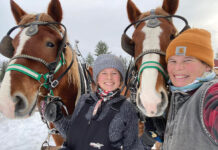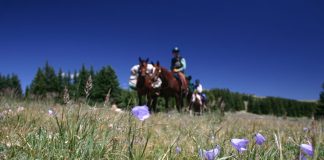Most riders have a dominant side, one that is stronger than the other and bears more of the rider’s weight in the saddle to compensate for the weaker side; however, many aren’t aware that they have straightness issues. Elizabeth Hanson developed Equestrian Pilates, a fitness program featuring three routines, to help riders become aware of and fix common posture, balance and flexibility issues while strengthening the areas of the body that are most important for proper riding. Here, excerpts from Hanson’s “Equestrian Pilates” e-book provide insight about one-sided weaknesses and exercises to remedy this common problem.
Understanding One-Sidedness
Fixing One-Sided Weakness
Many of the exercises Hanson uses to help riders improve their posture in the saddle require stretching, which restores the body’s balance.
Spinal Bridging
Benefits:
- Teaching you to move your hips evenly
- Increases flexibility in the spine
- Teaching you not to grip with your muscles
- Prevents a rigid posture
- Eliminate head bobbing
- Balances the seat
 Position A Position A |  Position B Position B |
Movement:
- Starting in Position “A”, inhale through the nose;
- Exhale through the mouth and engage the abdominal and pelvic muscles;
- Inhale through your nose;
- Exhale and raise your tailbone toward the ceiling, flattening your lower back. Curl your spine up one vertebra at a time;
- Hold the position for one inhale and exhale;
- Inhale to prepare for movement;
- Exhale and curl down one vertebra at a time, returning to Position “A”;
- Do six repetitions.
Awareness:
Keep your hips level during this exercise. Relax the glutei and leg muscles and focus on using the core and pelvic muscles.
Piriformis Stretch
Benefits:
- Stretches the piriformis muscle, which runs from the sacrum to the femur and rotates the thigh outward. When the thigh is flexed, the muscle pulls it away from the body.
- Increases flexibility of the muscle, which allows the hips and thighs to rotate inward and the inside of the leg to close around the horse.
 Position A Position A |  Position B Position B |
Movement:
- Starting in Position “A”, inhale through your nose
- Exhale through your mouth and lift your left knee toward your chest into the table top position
- Inhale
- Exhale and cross your left leg over your right knee
- Inhale
- Exhale and grasp the back side of your right thigh with your right hand and place your left hand on your left knee
- Inhale then exhale as you gently pull your right leg closer to your body and use your left hand to push your left knee away from your body
- Hold for a five count and repeat two more times
- Repeat on the opposite side three times.
Awareness:
Maximize the stretch by focusing on keeping your buttocks planted firmly on the ground and maintain a neutral spine. Try to not let your back flatten into the mat.
IT Band and Inner Thigh Stretch
The Ilio-Tibial Tract, or IT Band, is a long muscle in the thigh that stabilizes the knee, pulls the thigh away from the body and rotates it inward. For this exercise, you can use a lead rope.
Benefits:
Stretches the inside of the leg and the outside of the leg from the hip to the side of the knee.
 Position A |  Position B |
Movement:
- Start in Position “A” and inhale through your nose
- Exhale through your mouth, lift your right leg and put the lead rope over your foot. Hold both ends with your left hand and straighten your left leg
- Inhale
- Pull the lead rope until you feel tension against it and slowly pull your right leg across your body to the left as far as you can. Keep your hips and shoulders on the mat and hold for a count of five. Repeat three times
- Repeat four times with the left leg
 |
Inner Thigh
- Slowly pull your right leg over to the right as far as you can. Keep your left hip on the mat. Hold for a count of five and repeat three times
- Repeat four times with the left leg
Awareness:
Keep both shoulders on the mat and reach with your heel.
Hamstring Calf Stretch
Benefits:
- Balances the front and back of the legs
- Relieves tension and occasional soreness in these areas
 Position A |  Position B |
Movement:
- Stand up tall in front of a fence and inhale through your nose
- Exhale through your mouth and lift your right leg up to place it on the fence, pointing the toe
- Inhale
- Exhale and lean forward slowly, keeping your hips parallel to the fence. Don’t allow one hip to come forward in front of the other. Hold for a count of five and repeat three times
- Rotate the hip out, pointing your toe to the outside and repeat the stretch four times
- Rotate the hip in and repeat the stretch four times
- Repeat the exercise with the left leg.
Awareness:
Rotate the entire hip inward and outward when performing the external and internal rotation of this exercise. It is incorrect to only turn the toe in.
Read more on fitness for equestrians >>
Watch a video or download a podcast of equestrian exercises >>
For more information about Hanson’s Equestrian Pilates program and to order her e-book, go to equestrianpilates.com. Hanson offers classes at YogaWorks in Westlake Village, Calif.
Photos taken at Whitethorne Ranch
©Cynthia Berg Photography
Read more about Equestrian Pilates in the January 2010 issue of Horse Illustrated. Subscribe today!






Thank you so much for this information. It is exactly what I have been looking for. I am very one-sided because of a physical handicap, and no one seemed to have any advice for me. This exercise routine makes sense. Thank you.
good article
Looks good. Will give them a try.
very good!! really help with flexibility and balance. 🙂
Thanks you for the article. I didn’t know that the non dominant side would have the shorter muscles and would therfore be tighter. It makes so much sense. Thanks for showing me that the exercises I do routinely are the correct ones. Thanks Again.
These sound like a good way to straighten up. But how long does it take to do all this?